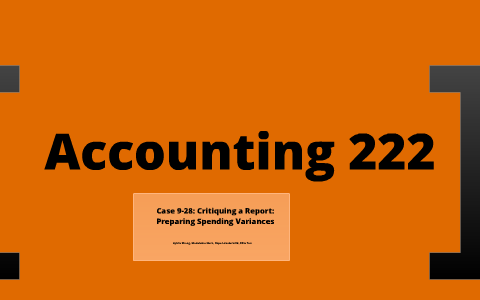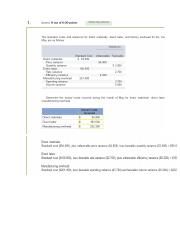It measures the difference between the budgeted and the actual level of activity valued at the standard fixed cost per unit. The fixed overhead volume variance is obtained by subtracting actual units produced from budgeted units and then multiplying the result with standard fixed cost per unit. The standard fixed cost per unit is obtained by dividing the budgeted fixed overhead by the budgeted production. It can also be obtained by subtracting actual hours incurred in production from the budgeted hours and then multiplying the result with the standard fixed cost per hour.
Fixed overhead expenditure variance is calculated by subtracting the actual fixed overhead cost from the budgeted fixed overhead cost. It can be favorable when the budgeted fixed overhead is less than the actual fixed overhead or adverse when the actual costs are more than the budgeted. In budgeting (or management accounting in general), a variance is the difference between a budgeted, planned, or standard cost and the actual amount incurred/sold. Variance analysis, also described as analysis of variance or ANOVA, involves assessing the difference between two figures.
It is a tool applied to financial and operational data that aims to identify and determine the cause of the variance. In applied statistics, there are different forms of variance analysis. In project management, variance analysis helps maintain control over a project’s expenses by monitoring planned versus actual costs.
For instance, a monthly closing report might provide quantitative data about expenses, revenue and remaining inventory levels. Variances between planned and actual costs might lead to adjusting business goals, objectives or strategies. This is the difference between the actual and budgeted variable overhead costs that result from inefficient use of indirect materials and indirect labor.
Overhead variance occurs when the day-to-day costs of running a business differs from the amount budgeted and can occur with both variable and fixed overheads. Sales variance is the difference between planned or expected sales and actual sales made. Analysing sales variance helps to measure sales performance, understand market conditions and evaluate business results.
It is favorable when the actual units produced are more than the budgeted units and adverse when the number of units produced are less than the budgeted. Variance analysis is important to assist with managing budgets by controlling budgeted versus actual costs. In program and project management, for example, financial data are generally assessed at key intervals or milestones.
Variance is the difference between budgeted or planned costs or sales and actual costs incurred or sales made. Your variable components may consist of things such as indirect material, and direct labor, and supplies.
Factory Overhead Variances
How do you calculate spending variance?
A spending variance is the difference between the actual and expected (or budgeted) amount of an expense. The spending variance for fixed overhead is known as the fixed overhead spending variance, and is the actual expense incurred minus the budgeted expense.
Actual overhead variances are those that have been incurred and can be known at the end of a particular accounting period after the accounts have been prepared. Absorbed overheads are overheads charged to a product based on a predetermined overhead rate, which is the standard overhead absorption rate. Understanding and analysing variance helps businesses understand current outgoings and budget for future expenses. Businesses therefore carry out variance analysis – a quantitative investigation into the differences between planned and actual costs and revenues.
If such analysis is not carried out in regular intervals, it may cause a delay in the management action to control its costs. Managers acknowledge that it is impossible to exactly attain budgeted estimates, such as targeted profits. A variance is a difference between the actual figures and budgeted estimates. Overhead variance arises due to the differences between actual overhead variances and the budgeted or the absorbed variances.

When conducting variance analysis consider your actual revenue and/or costs versus your budgeted figures. Are there small, continual changes over time that are diverging from your planned budget? Analysis of these trends from month to month will help you get a better understanding of where your variance is coming from. Higher than expected expenses can also cause an unfavorable variance. For example, if your budgeted expenses were $200,000 but your actual costs were $250,000, your unfavorable variance would be $50,000 or 25 percent.
- It measures the difference between the budgeted and the actual level of activity valued at the standard fixed cost per unit.
- The standard fixed cost per unit is obtained by dividing the budgeted fixed overhead by the budgeted production.

Direct Material Variances
Variance analysis is usually associated with explaining the difference (or variance) between actual costs and the standard costs allowed for the good output. For example, the difference in materials costs can be divided into a materials price variance and a materials usage variance. The difference between the actual direct labor costs and the standard direct labor costs can be divided into a rate variance and an efficiency variance. The difference in manufacturing overhead can be divided into spending, efficiency, and volume variances. Thus, Variance Analysis is important to analyze the difference between the actual and planned behavior of an organization.
Fixed overhead may include rent, car insurance, maintenance, depreciation and more. Variance analysis for overhead is split between variances related to variable and fixed costs. This is the difference between the standard and actual cost per unit of the direct materials purchased, multiplied by the standard number of units expected to be used in the production process. This is the difference between the budgeted fixed overheads and the standard fixed overheads absorbed on actual production.
What is the fixed overhead spending variance?
The fixed overhead spending variance is the difference between the actual amount of fixed overhead and the budgeted amount of fixed overhead. If the company spent more than it should have (according to the standard, which is set by management) on fixed overhead, then the fixed overhead spending variance is unfavorable.
What Is A Spending Variance?
Ideally, your actual costs should match what you budgeted and your cost variance should be zero, but in practice this is fairly difficult to achieve. This is the difference between the actual and budgeted number of units sold, multiplied by the budgeted contribution margin. This measure is used to determine the impact on the overall sales margin of differences in the expected mix of units sold.
The budget is the primary tool financial analysts use to manage expenses and variances from the budget. By comparing the budget to actual numbers, analysts are able to identify any variances between budgeted and true costs. The higher the variance, the more help is needed in terms of management. The best way to manage variances is to have monthly reports and regular meetings to discuss these discrepancies with management and department heads.
Variable overhead efficiency variance is calculated by subtracting the standard budgeted hours from the actual hours incurred, and then multiplying the result with the standard variable overhead rate. A favorable variance results when the actual hours used are less than the budgeted while an adverse variance results from use of more hours than the budgeted. This is the difference between the budgeted fixed overhead expenditure and the actual fixed overhead incurred. It arises due to changes in the cost of fixed overhead during the period.
Effective variance analysis can help a company spot trends, issues, opportunities and threats to short-term or long-term success. Variance analysis helps management to understand the present costs and then to control future costs.
Unfavorable budget variances refer to the negative difference between actual revenues and what was budgeted. This usually happens when revenue is lower than expected or when expenses are higher than expected.
This also allows you to hold specific managers accountable for minimizing budget variance. Cost variance allows you to monitor the financial progression of whatever it is you are doing in your business. When cost variances are low, you know you have controlled your risks well. You also know you have retrieved and analyzed data related to operations sufficiently.
Variance calculation should always be calculated by taking the planned or budgeted amount and subtracting the actual/forecasted value. Thus a positive number is favorable and a negative number is unfavorable.